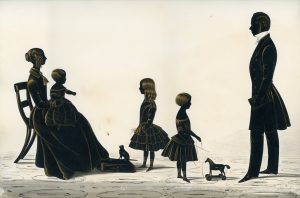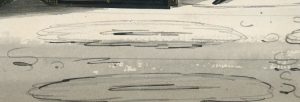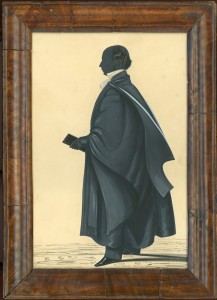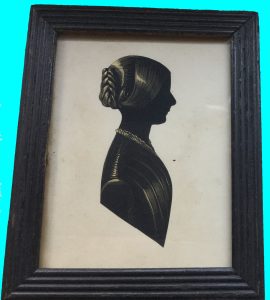Merryweather – From Boom to Bust
Edward Merryweather was not a prolific silhouette artist so verified examples of his work are few and far between, making them prized amongst collectors. Recent research has revealed that he took up silhouette cutting late in life having previously worked in two other lines of business.

© Wigs on the Green
Merryweather cut both full- and bust-length silhouettes which were then finely bronzed. Some full-length profiles were over-painted in shades of grey watercolour and Chinese white with bronzed highlights. A stylistic trait that helps in the identification of his work is a patterned floor of concentric circles and S-shapes.

Edward Merryweather was born around 1775 in a district of Doncaster known as Red House. His parents have not been traced; he had an older brother, John, who became a saddler and trunk maker with premises on Doncaster High Street.
Edward’s first career was as a builder in the neighbouring town of Conisbrough. It was there that he met and, in May 1811, married Essex-born Catharine Miles. Their first two children were born in Doncaster: Emma in January 1814 and George Edward in June 1817. Edward Merryweather was prospering, so much so that around 1818 he invested in a small plot of land at Red House where he then built at least one house.
If the family lived in the newly-built house, it was only for a few years as by March 1826, when their third child Julia was born, they were living in Cheetham Hill, Manchester. As well as a new home, Edward also had a new career as an art dealer. His property development schemes must have generated substantial capital as by 1828 Merryweather had a gallery at Wright’s Court in Manchester. Close to the busy Market Street, Wright’s Court attracted a select group of small businesses including a wine merchant, a bookseller and an engraver.
When Merryweather advertised his gallery in the Manchester Courier (27 Sept. 1828) he had in stock ‘genuine and capital pictures, by the very first Masters’. It was a collection that was top-heavy with 17th century Baroque artists including Van Dyck and Salvador Rosa. Even in the 1820s such paintings required a sizeable investment. Merryweather sourced his stock at local auctions. At Christie’s Tabley House sale in July 1827 he purchased the star lot – ‘Intruding Puppies’ by Edwin Landseer – for a cool £173 5s (the equivalent of £20,000 today). The painting was subsequently sold on to a Yorkshire art collector.
Merryweather’s art dealing career continued into the 1840s. The 1841 Census shows him as a Picture Merchant still living in Cheetham with his wife and 15-year-old daughter. But all was not well. It would appear that Merryweather had a problem with cashflow as in late 1841 he put three of his houses up for auction. He also moved with his family back to Doncaster. It was not enough though to stave off disaster as in June 1844 he was made bankrupt and imprisoned in York Castle (Leeds Intelligencer, 15 June 1844). Having served four months, he was conditionally discharged.
This marked the end of Merryweather’s career as an art dealer and signalled his new career as a silhouette artist. This may have been an earlier hobby or he may have learned to cut silhouettes during his time in prison, perhaps inspired by a fellow inmate? His work was professional: neatly cut and well-finished. He either signed Merryweather or used a stencil stamp on the reverse.

© Wigs on the Green
By the time of the 1851 Census Edward Merryweather was 76, working as an artist from 64 Cleveland Street, Doncaster. Still living with him was his wife Catharine and their 25 year old daughter Julia, a milliner and dressmaker. Edward Merryweather died that same year in May 1851 and was buried at St George’s in Doncaster.
Following Edward’s death his family upped sticks and moved back to Manchester. His widow continued to live with their younger daughter, Julia, until her death in 1867. By then, their elder daughter, Emma, had married a Manchester schoolmaster and had one child Fanny, whilst Julia had three children, Eleanor Florence, Henry, and Samuel out of wedlock. She was 44 before she finally married a coachman, Thomas Bates, in 1870. Economical with the truth, she knocked a few years off her age claiming to be 36, her new husband being 37! No further trace of their son, George Edward, has been found.

© Private Collection